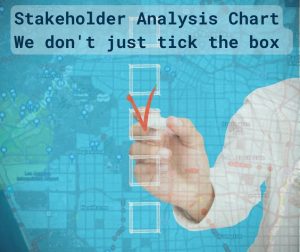 Engaging communities in the decision-making process lies at the heart of sustainability and good governance. By its very nature, community engagement is a dynamic and highly interactive endeavor that necessitates clear communication, empathetic understanding, and strategic planning. It is not marketing or public relations, it is the community working together as partners to solve problems and thrive. In the realm of modern tools and methodologies, A&D Solutions have evolved stakeholder analysis charts from static representations of influence and interest to dynamic maps harnessing the powerful capabilities of Geographic Information Systems (GIS). This evolution is not merely a technological leap; it is a shift in mindset, one that prioritizes the inclusion of every voice through the lens of diversity, equity, inclusion, and environmental justice (JDEI). At A&D Solutions we are journeying into the heart of stakeholder analysis and exploring groundbreaking approaches paving the way for more equitable and effective community engagement. But how ? How can we not merely check the box? How can we foster collaboration, transparency and meaningful engagement throughout the project lifecycle?
Engaging communities in the decision-making process lies at the heart of sustainability and good governance. By its very nature, community engagement is a dynamic and highly interactive endeavor that necessitates clear communication, empathetic understanding, and strategic planning. It is not marketing or public relations, it is the community working together as partners to solve problems and thrive. In the realm of modern tools and methodologies, A&D Solutions have evolved stakeholder analysis charts from static representations of influence and interest to dynamic maps harnessing the powerful capabilities of Geographic Information Systems (GIS). This evolution is not merely a technological leap; it is a shift in mindset, one that prioritizes the inclusion of every voice through the lens of diversity, equity, inclusion, and environmental justice (JDEI). At A&D Solutions we are journeying into the heart of stakeholder analysis and exploring groundbreaking approaches paving the way for more equitable and effective community engagement. But how ? How can we not merely check the box? How can we foster collaboration, transparency and meaningful engagement throughout the project lifecycle?
The Evolving Role of Stakeholder Analysis:
In the context of community engagement, stakeholder analysis serves as a compass, guiding planners and decision-makers through the often-complex task of identifying those who will be affected by a proposed project or policy. Traditionally, this process involved creating lists of groups or individuals, rating their level of interest and influence, and using this information to shape communication and engagement strategies. While still a valuable tool in its own right, traditional stakeholder analysis can become the very antithesis of inclusive community engagement if not thoughtfully reimagined.
A&D Solutions: Pioneering Innovation:
A&D Solutions leads the charge in JDEI-driven stakeholder analysis with their unique stakeholder analysis chart design. Their GIS-powered methodology captures ecological and socio-cultural nuances, going beyond spatial mapping. Their work on stewardship initiatives like the Ballona Wetlands showcases the power of inclusive engagement.
Staying Ahead with Dynamic Analytics:
Digital stakeholder analysis offers agility and adaptability. Real-time data updates ensure engagement efforts remain relevant and that community workshops and events are mapped. It’s an ongoing dialogue, not a one-time event.
In Conclusion: We Engage with Purpose, We Don’t Just Check The Box:
The true value of stakeholder analysis lies in its inclusivity. Organizations embracing JDEI-driven approaches shape a more equitable future. Remember, the map guides, but it’s the journey of engagement that truly matters. After all, we do not know who will have the next big idea that will change the world.
